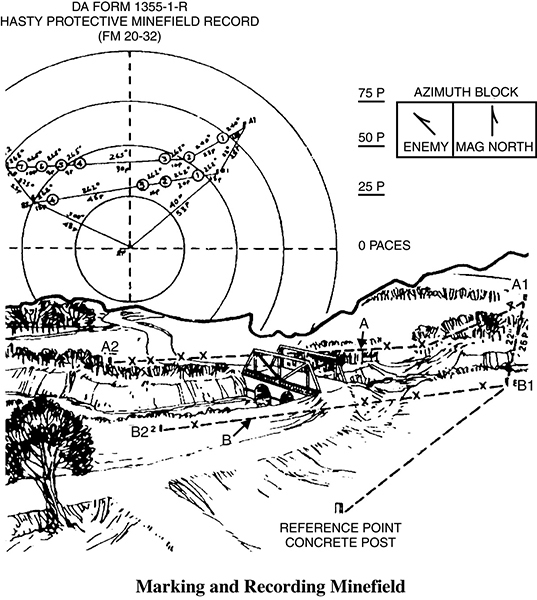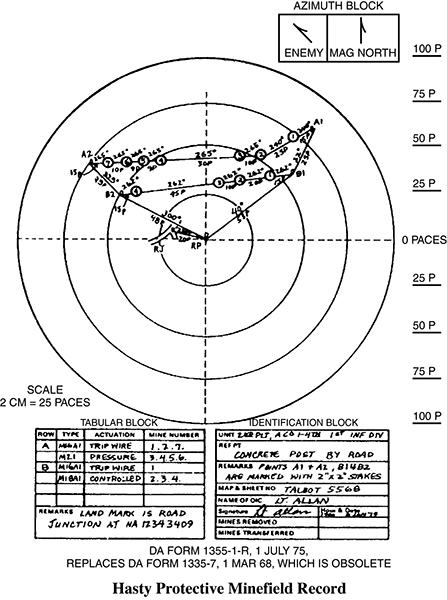Only metallic mines are used in hasty protective minefields. Booby traps are not used because they delay removal of the mines. The employing platoon must make sure that the minefield can be kept under observation and covered by fire at all times. The following example describes how to lay a hasty protective minefield.
After requesting and receiving permission to lay the minefield, the platoon leader and squad leaders reconnoiter to determine exactly where to place the mines. The leaders determine a need to use antitank mines to block enemy vehicles at the bridge and the ford. The leaders also decide that antipersonnel mines are needed to protect the antitank mines and to cover the likely avenues of approach of enemy infantry.
While the soldiers are placing the mines, the platoon leader finds an easily identifiable reference point (a concrete post) in front of the platoon’s position. The platoon leader records the minefield using a reference point. The row of mines closest to the enemy is designated A; the succeeding rows are B, C, and so on. The ends of a row are shown by two markers. They are labeled with the letter of the row and number 1 for the right end of the row or number 2 for the left end of the row. The rows are numbered from right to left, facing the enemy. The marker can be a steel picket or a wooden stake with a nail or can attached so that it can be found with a metallic mine detector.
From the base reference point (the concrete post), the platoon leader measures the magnetic azimuth in degrees and paces the distance to a point between fifteen and twenty-five paces to the right of the first mine on the friendly side of the minefield. This point, B-1, marks the beginning of the second row. The platoon leader places a marker at B-1 and records the azimuth and distance from the concrete post to B-1 on DA Form 1355-1-R.

Next, from B-1 the platoon leader measures the azimuth and distance to a point fifteen to twenty-five paces from the first mine in row A. He places a marker at this point and records it as A-1. The platoon leader then measures the distance and azimuth from A-1 to the first mine in row A and records the location of the mine. He then measures the distance and azimuth from the first mine to the second, and so on until all mine locations have been recorded as shown. The platoon leader gives each mine a number to identify it in the tabular block of DA Form 1355-1-R. When the last mine location in row A is recorded, the platoon leader measures an azimuth and distance from the last mine to another arbitrary point between fifteen and twenty-five paces beyond the last mine. He places a marker here and calls it A-2. The platoon leader follows the same procedure with row B.
When the platoon leader finishes recording and marking the rows, he measures the distance and azimuth from the reference point to B-2 to A-2, and records them. Note: If antitank mines are being used, it is recommended that they be used at the A-2/B-2 markers, because their large size facilitates retrieval.
The platoon leader now ties in the reference point with a permanent landmark that he found on the map. He measures the distance and azimuth from this landmark to the reference point. The landmark might be used to help others locate the minefield should it be abandoned. Finally, he completes the form by filling in the tabular and identification blocks.
While the platoon leader is tying in the landmark, the soldiers arm the mines nearest the enemy first (row A). The platoon leader reports that the minefield is completed and keeps DA Form 1355-1-R. If the minefield is transferred to another platoon, the gaining platoon leader signs and dates the “Mines Transferred” block and accepts the form from the previous leader. When the minefield is removed, the form is destroyed. If the minefield is left unattended or abandoned unexpectedly, the form must be forwarded to the company commander. The company commander forwards it to the battalion to be transferred to more permanent records.
When retrieving the mines, the soldiers start at the reference point and move to B-1, using the azimuth and distances as recorded. They then move from B-1 to the first mine in row B. However, if B-1 is destroyed, they move from the reference point to B-2 using that azimuth and distance. They will have to shoot the back azimuth from B-2 to the last mine. The stakes at A-1, B-1, A-2, and B-2 are necessary because it is safer to find a stake when traversing long distances than to find a live mine. Some rules to remember:
•Measurements are in meters.
•The minimum distance between rows of antitank (AT) mines is 8 meters.

•In Korea only, the minimum distance between any row and a row containing AP mines is 15 meters.
•The distance between the start row marker and the first mine in a row is the mine spacing for that row.
•Start and end row markers are permanent markers and must be made of detectable material.
•The spacing between mines is at least 4 meters to prevent sympathetic detonation. There is no maximum distance between mines within the row.
•The minefield must be fenced on all sides if M18A1 AP mines are employed and the minefield will be in place for more than seventy-two hours.
•The minefield has at least one landmark that is located to the rear, never to the extreme side or front.
•AHDs, nonmetallic mines, or low-metallic mines are not used.
POINT MINEFIELDS
Point minefields disorganize enemy forces and hinder their use of key areas. Point minefields are of irregular size and shape and include all types of antitank and antipersonnel mines and antihandling devices. They should be used to add to the effect of existing and reinforcing obstacles, or to rapidly block an enemy counterattack along a flank avenue of approach.
PHONY MINEFIELDS
Phony minefields, used to degrade enemy mobility and preserve friendly mobility, simulate live minefields and deceive the enemy. They are used when lack of time, personnel, or material prevents the use of actual mines. Phony minefields may be used as gaps in live minefields. To be effective, a phony minefield must look like a live minefield, which is accomplished by either burying metallic objects or making the ground look as though objects are buried.
Appendix E
Platoon and Squad Organization
All infantry platoons and units acting as infantry use the same basic doctrinal principles in combat, but some differences exist between organizations. Most units operate from a modified table of organization and equipment (MTOE) based on their organization, mission, and location. Rifle platoons are organized as light infantry, mechanized infantry, infantry, air assault infantry, airborne infantry, or Ranger infantry. The importance of organizing units for combat cannot be overemphasized. All military units, regardless of classification as combat arms, combat support, or combat service support, should have a fighting organization. The enemy doesn’t care what your specialty is; if you are a cook, mechanic, or other noninfantry element, you need to have a fighting battle roster for those times when you will need to defend yourself. The war in Iraq and the war on terrorism in Afghanistan and around the world have proven to us that there is no safe military occupational duty specialty. Every unit needs to have the minimum ability to fight and defend itself as a collective fighting force.
The most common organization is that of the light infantry platoon, and it is the easiest to duplicate with soldiers who are not used to being infantry. It consists of three rifle squads and a platoon headquarters with two machine-gun teams (if available). Each machine-gun team has a gunner and an assistant gunner. The antiarmor weapons are distributed evenly throughout the squads and are usually assigned to more seasoned soldiers.